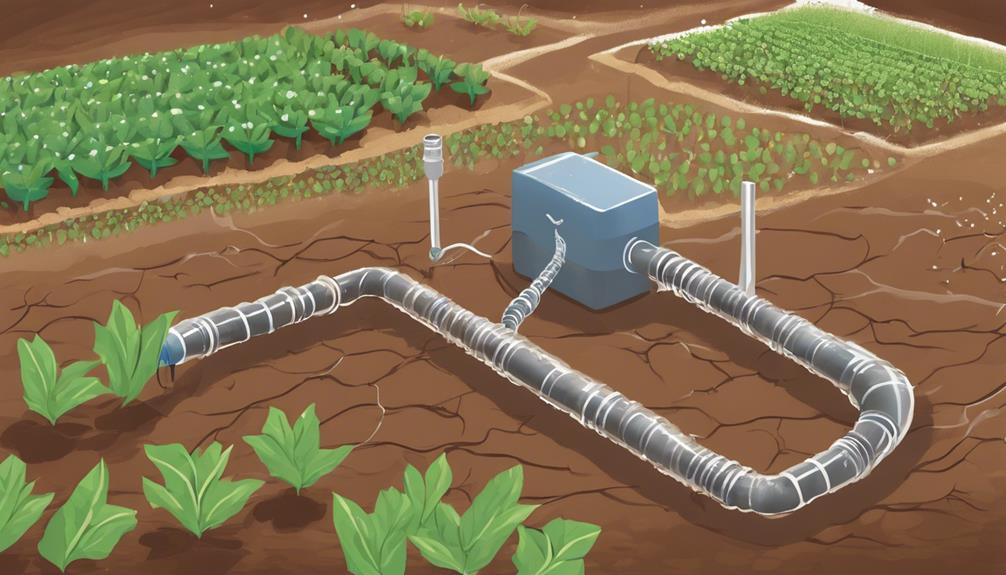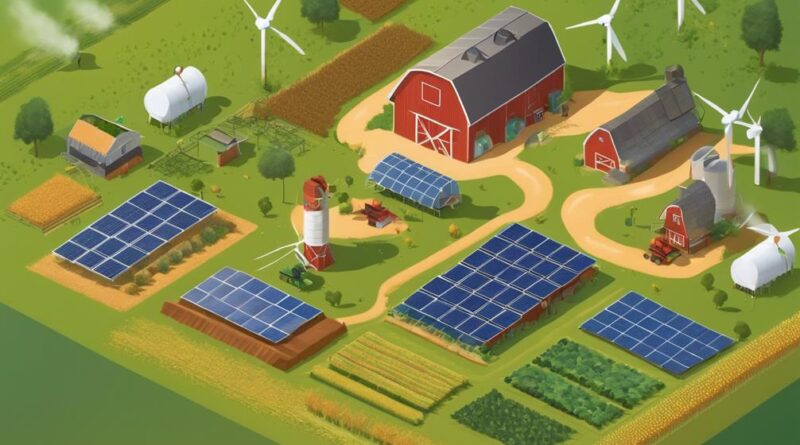7 Best Eco-Friendly Farming Techniques Minimizing Carbon Emissions
To minimize carbon emissions in your farming, try these techniques: Crop rotation boosts soil health and reduces the need for synthetic inputs. Cover cropping maintains soil structure and prevents erosion. Reduced tillage cuts down on carbon release from soil disturbance. Integrate trees into your farm with agroforestry practices for carbon sequestration. Manage pests with integrated pest management to lower pesticide use. Opt for organic farming methods to reduce synthetic fertilizers and pesticides which contribute to carbon emissions. Utilize precision nutrient application for efficient use of fertilizers. These methods offer a strong foundation for sustainable and eco-friendly farming practices.
Crop Rotation
Implementing crop rotation in your farming practices can significantly improve soil health and reduce the need for chemical fertilizers. This age-old technique involves alternating the types of crops grown in a particular field seasonally or annually. By diversifying the plant species in your fields, you enhance soil health through the promotion of biodiversity.
Soil health is vital for sustainable agriculture, as it directly impacts crop productivity and environmental sustainability. Crop rotation helps maintain soil fertility by preventing the depletion of specific nutrients. Different crops have varying nutrient requirements, and rotating them helps balance the soil's nutrient levels naturally. This practice also disrupts the life cycles of pests and diseases that target specific crops, reducing the need for chemical interventions.
Furthermore, crop rotation promotes biodiversity by creating a more varied habitat for beneficial insects, microbes, and other organisms crucial for soil health. Different crops attract different types of organisms, fostering a balanced ecosystem within the soil. This biodiversity promotes natural soil processes like nutrient cycling, decomposition, and pest control, reducing the reliance on synthetic inputs.
Incorporating crop rotation into your farming regimen demonstrates a commitment to sustainable practices that benefit both your farm's productivity and the environment. By prioritizing soil health and biodiversity promotion, you contribute to a more resilient and eco-friendly agricultural system.
Cover Cropping
To further enhance your soil health and bolster sustainable farming practices, consider integrating cover cropping into your agricultural methods. Cover cropping involves planting specific crops during off-seasons or alongside cash crops to protect and enrich the soil. These cover crops play a vital role in improving soil health and promoting carbon sequestration.
One of the key benefits of cover cropping is its positive impact on soil health. By diversifying plant species in your fields, you can improve soil structure, increase microbial activity, and enhance nutrient cycling. The roots of cover crops help prevent soil erosion, retain moisture, and suppress weeds, contributing to overall soil quality. This healthier soil not only supports crop growth but also reduces the need for synthetic fertilizers and pesticides.
Moreover, cover cropping is an effective strategy for carbon sequestration. When cover crops photosynthesize, they take in carbon dioxide from the atmosphere and store it in the soil as organic matter. This process helps mitigate climate change by reducing the amount of carbon released into the air. By incorporating cover crops into your farming practices, you can actively contribute to carbon sequestration efforts while improving the long-term sustainability of your fields.
Reduced Tillage
Minimizing tillage practices can significantly benefit soil health and enhance sustainability in farming operations. Reduced tillage techniques involve disturbing the soil less frequently and to a lesser extent compared to conventional tillage methods. By reducing the intensity of soil disturbance, farmers can improve soil structure, increase organic matter content, and promote better water infiltration and retention. These practices not only contribute to enhanced soil health but also play a crucial role in carbon sequestration.
When you implement reduced tillage strategies on your farm, you help sequester carbon in the soil. Excessive tillage releases carbon dioxide into the atmosphere, contributing to greenhouse gas emissions. By minimizing tillage, you can help trap carbon in the soil, reducing the carbon footprint of your farming operations. This process not only benefits the environment by mitigating climate change but also enhances the long-term productivity and sustainability of your land.
Incorporating reduced tillage practices into your farming techniques requires careful planning and adjustment. It involves adopting conservation tillage methods such as no-till or minimum tillage, depending on your specific crop and soil conditions. By prioritizing soil health and carbon sequestration through reduced tillage, you can contribute to a more sustainable and environmentally friendly farming system.
Agroforestry Practices
Reducing tillage practices can lead to significant benefits for both soil health and environmental sustainability, paving the way for the integration of agroforestry practices on your farm. Agroforestry involves strategically planting trees amidst crops or livestock, offering a range of advantages for your agricultural operations.
By incorporating tree planting into your farm, you can enhance soil enrichment through the trees' root systems. These roots help prevent soil erosion, improve water retention, and increase nutrient availability. As the trees grow, they also contribute to carbon sequestration, effectively capturing and storing carbon dioxide from the atmosphere. This process aids in mitigating the impacts of climate change by reducing the overall carbon footprint of your farm.
Furthermore, agroforestry promotes biodiversity by creating diverse habitats that support a variety of plant and animal species. The presence of trees attracts beneficial insects, birds, and other wildlife, fostering a balanced ecosystem within your farm. This biodiversity not only contributes to a healthier environment but also aids in natural pest control, reducing the need for harmful pesticides.
Incorporating agroforestry practices on your farm can lead to a more sustainable and resilient agricultural system, benefiting both the environment and your overall productivity.
Integrated Pest Management
Implementing diverse pest control strategies is essential for maintaining a healthy ecosystem on your farm while ensuring optimal crop protection. When it comes to integrated pest management, utilizing natural predators and companion planting are effective methods to keep pest populations in check without relying heavily on chemical pesticides.
Introducing natural predators to your farm can help control pest populations in a sustainable way. Predatory insects like ladybugs, lacewings, and predatory mites feed on common crop pests such as aphids, thrips, and spider mites. By attracting and maintaining populations of these beneficial insects in your fields, you can reduce the need for synthetic pesticides while promoting a natural balance that supports your crops' health.
Companion planting involves strategically interplanting different crops to confuse pests, repel harmful insects, or attract beneficial ones. For example, planting marigolds alongside tomatoes can deter nematodes, while growing basil near peppers can help repel aphids. Additionally, certain plant combinations can enhance soil health and nutrient uptake, further supporting your crops' natural defense mechanisms.
Nutrient Management
To optimize crop growth and minimize environmental impact, efficient nutrient management is crucial on your farm. Proper management techniques not only enhance soil health but also reduce the carbon footprint of your agricultural practices. Here are some key strategies to consider:
- Soil Testing: Conduct regular soil tests to determine nutrient levels and pH balance. This information will help you make informed decisions about the types and quantities of fertilizers needed, preventing over-application and nutrient imbalances.
- Composting: Implement composting techniques to recycle organic matter from crop residues, manure, and kitchen scraps. Compost not only improves soil structure and fertility but also reduces the reliance on synthetic fertilizers, thus lowering carbon emissions.
- Cover Cropping: Integrate cover crops into your farming system to prevent soil erosion, suppress weeds, and add organic matter back into the soil. Cover crops also help in fixing nitrogen levels naturally, reducing the need for nitrogen-based fertilizers.
- Precision Nutrient Application: Utilize precision agriculture technologies to apply fertilizers accurately and efficiently, targeting specific areas of the field where nutrients are most needed. This approach minimizes waste and ensures optimal nutrient uptake by the crops, promoting both productivity and environmental sustainability.
Water Conservation

Efficient water management practices are essential for sustainable agriculture and maximizing crop yields while minimizing environmental impact. By incorporating techniques like drip irrigation efficiency and rainwater harvesting, farmers can significantly reduce water waste and ensure that crops receive an adequate amount of water precisely where it's needed. Drip irrigation systems deliver water directly to the plant roots, minimizing evaporation and runoff. This method not only conserves water but also promotes plant growth and reduces the risk of diseases associated with overwatering.
In addition to drip irrigation, greywater recycling plays a crucial role in sustainable irrigation practices. Greywater, which includes water from bathroom sinks, showers, and laundry machines, can be treated and reused for irrigation purposes. By implementing greywater recycling systems, farmers can reduce their reliance on freshwater sources, leading to significant water savings and a more environmentally friendly farming operation.
Furthermore, rainwater harvesting is another effective way to conserve water on farms. Collecting rainwater allows farmers to store water for future use during dry periods, reducing the need to extract water from other sources. Sustainable irrigation practices, such as these, not only benefit the environment by conserving water resources but also contribute to improved crop yields and long-term agricultural sustainability.
Conclusion
In conclusion, adopting eco-friendly farming techniques such as crop rotation, cover cropping, reduced tillage, agroforestry practices, integrated pest management, nutrient management, and water conservation can significantly minimize carbon emissions and promote sustainable agriculture.
By implementing these practices, farmers can't only reduce their environmental impact but also improve soil health, increase biodiversity, and enhance overall farm resilience.
Embracing these methods is crucial in mitigating climate change and ensuring a healthier future for our planet.
